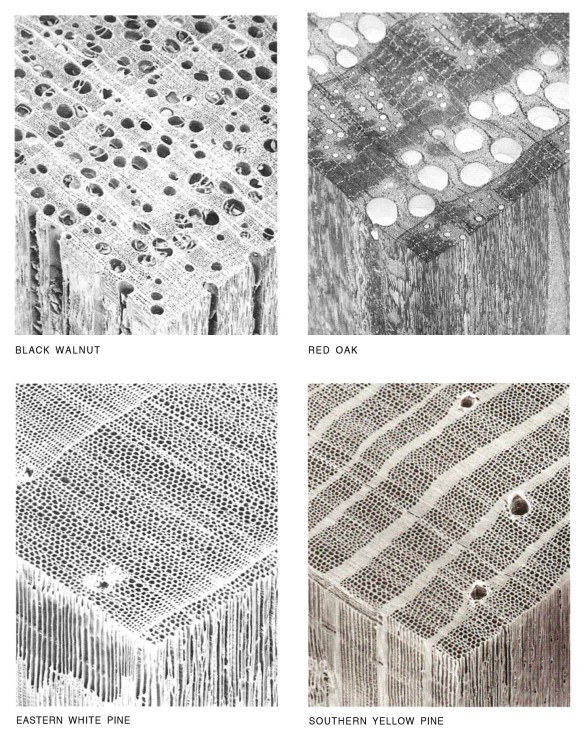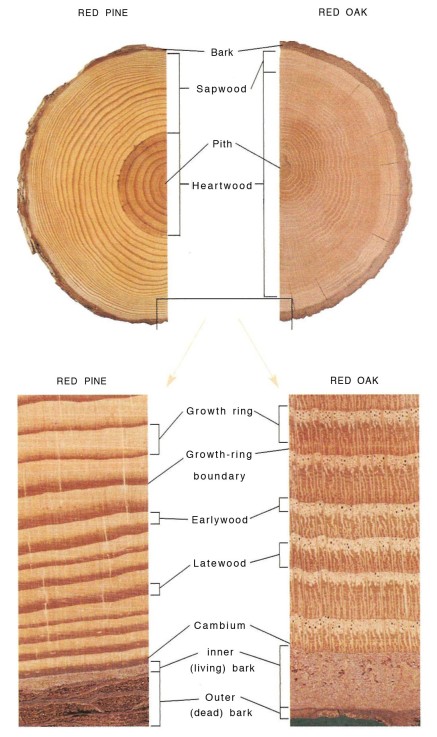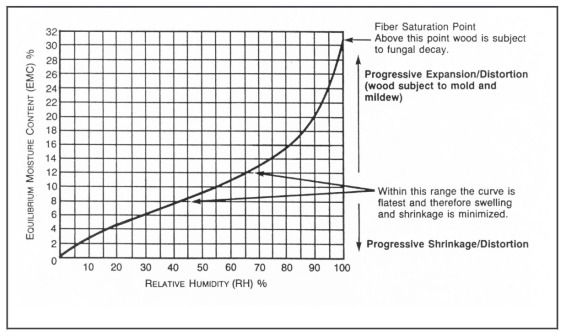Cellular Structure
To understand the behavior of wood and its requirements for long term preservation, one can benefit by looking at the physical and cellular structure of a tree. Wood is a porous three dimensional, hydroscopic, interconnecting matrix of cellulose, hemicelluloses and lignin. In simple terms, a tree can be described as a bundle of vessels, its walls composed of cellulose glued together with lignin. These vessels or cells transport food and waste products through the tree. New cells grow around the circumference of the tree, forming a ring just within the bark. Within the bark and comprising the bulk of the stem is the wood, characterised by its many growth rings concentrically arranged around the central pith. The tree stem parts are accumulations of countless cells. The cell is the basic structural unit of plant material. Each cell consists of an outer cell wall surrounding an inner cell cavity. Wood cells are longer than they are wide and are mostly oriented parallel to the long axis of the trunk and branches. Figure 1 shows the cell structure of pine wood, looking at it from different cross sections.
Wood classifications and cellular structures
Timbers are divided into two categories based on their botanical order:
- Softwoods are derived from conifers— gymnosperms;
- Hardwoods are derived from dicotyledons or broad-leaved trees—angiosperms.
| Physical characteristics of Hardwood Trees | Physical characteristics of Softwood Trees |
| Broad leaves | Needles |
| Deciduous or evergreen | Evergreen |
| Flowers or seeds | Cones or seeds |
These classifications are not related to the hardness or the softness of the materials, being based primarily on the presence of pores (hardwoods) or their absence (softwoods) in the cellular structure of the timber. Hardwoods have specialised structures called vessels for conducting sap upward. Vessels are a series of relatively large cells with open ends, set one above the other and continuing as open passages for long distances. On the end grain or a cross section of the log under the microscpe, vessels appear as holes and are known as pores. The size, shape, and arrangement of pores vary considerably between species, but are relatively constant within a species. Because all hardwoods possess vessels, they are sometimes called porous woods (softwoods are therefore called nonporous woods). There are significant physical structural differences between softwoods and hardwoods. These allow them to be distinguished from each other by microscopic examination. Every timber species has a characteristic arrangement of cells and tissues which enables it to be specifically identified. Figure 2 reveals cell structures of Black Walnut and Red Oak with distinguished pores, characteristic of all hardwoods. The Eastern White Pine and the Southern Yellow Pine without the distinguished large pores are softwoods.

(Fig. 2) Characteristic cell structure and the differences between hardwoods and softwoods is visible in these photos made with a scanning electron microscope. (Hoadley, 2000, Understanding Wood, pp.17)
Softwoods with density ranging between 400 and 670 kg.m‾³ have relatively long fibres enabling good fibre overlap, good interlocking of fibres, and consequently stiffness and good impact resistance. They contain alternate layers of earlywood, which has a low density, and latewood, which has a density three times greater. This structure has the disadvantage of alternate weak and strong layers, but has the advantage that metal fixings can be inserted with little danger of splitting. Hardwoods with density between 160 to 1200 kg.m‾³ on the other hand, have shorter fibres, which means less fibre overlap than with softwoods, and lesser the interlocking fibres, the lesser the wood’s stiffness. Because of the large differences in density between the lightest and the heaviest hardwoods, their properties vary very much. The heaviest tend to be used either for their good mechanical properties, their natural durability in severe conditions, or for their natural beauty and ability to accept polishing when used for furniture and other decorative purposes (Hoadley, 2000).
Physical Structure
Examination of the cross sectional surface of a tree trunk reveals three distinct zones (Fig. 3): the bark, the light coloured outer region (the sapwood) and the dark coloured region (the heartwood). These sapwood and heartwood zones serve distinct functions in the living tree and have very different characteristics that influence the behavior of wood even after it has been fashioned into objects. Sapwood is composed of newer living cells, which transport sap or water to the leaves and which store nutrients. As sapwood ages and becomes heartwood, extractives form within the cell walls, giving it color, durability, and dimensional stability (Fig. 4). The chemical defenses found in the extractives help protect heartwood lumber from biological attack. Sapwood is less resistant to fungi. Decay resistance of a species is due to the toxicity of the extractives to fungi. Extractives also often make the heartwood a little denser than the sapwood and also a little more stable in changing moisture conditions. These explains why heartwood is used more readily in furnitures, buildings, sculptures and other artefacts that are made to last.
In the temperate climate, the characteristic annual cycle includes a growing season and a dormant season. In most trees, the nature of wood cell formation is similarly cyclic, resulting in visible growth layers seen as growth rings in the cross section of a tree. Where there is visible contrast within a single growth ring, the first formed layer is termed earlywood, the remainder late wood (Fig. 3). The transition from earlywood to latewood may be abrupt or gradual. In some species no separable earlywood and latewood portions are apparent. In some tropical areas, tree growth may continue without the interruption of seasonal dormancy, producing wood without apparent growth rings.
The three principle planes in a block of wood are:
• Cross section (sometimes referred to as transverse or end grain);
• Radial section;
• Tangential section.
In the cross section plane, because the cell cavities are exposed in end grain, water is both easily absorbed and given off. The surface is hard and prone to splitting. It does not take stain or finish well and cannot be sanded smooth.
The radial plane extends along the long axis of the tree, more or less perpendicular to the growth rings. The grain pattern on this vertical or edge grain is usually straight and regular. Boards cut along this plane are dimensionally stable and distort very little in response to changes in ambient relative humidity. They will also stand up to abrasion and weathering.
The tangential plane extends along the long axis of the tree and forms a tangent with the concentric growth rings. Boards cut along this plane will swell, contract, and become distorted at twice the rate of those cut on a radial plane.
There is a very strong molecular attraction between water and the cellulose in wood. In freshly cut wood, water is found in both vessel cavities and cell walls. As the wood dries, the water in the cavities evaporates, but as long as the bound water remains in the walls, the wood will stay at the fibre saturation point and will not shrink. The moisture content at saturation is about 25%. When below this point, the wood will respond to changes in ambient relative humidity. Air-dried wood will reach a moisture content of 10%-12%, while kiln-dried wood will reach a moisture content of about 7%. This kiln-dried wood or the objects fashioned from it will absorb water vapour if placed in an environment with high relative humidity (RH).
Wood will eventually arrive at equilibrium with its environment, neither absorbing moisture (swelling) nor giving off moisture (shrinking), as long as the RH remains constant. See Figure 7 for a graph that illustrates the relationship between relative humidity and equilibrium moisture content in wood. This graph can help you calculate the amount of contraction or expansion that may occur in wooden objects.
When moisture is absorbed and released, the cell walls expand and contract. The cell length, however, remains nearly unchanged. Therefore, dimensional change in wood is not uniform in all planes. While movement along the longitudinal plane (the long axis of the tree) is negligible (only about 1%), movement across this plane is significant. Along the tangential plane, dimensional change is the greatest, averaging about 8%. Along the radial plane, dimensional change averages about 4%.





